THE BODY
Postmortem photography was widespread in Europe and America during the nineteenth century.18 The practice of photographing people after death, which began very early in the history of the medium, was performed as a special service by portrait photographers. Like portraiture, it was at first accomplished almost exclusively by the daguerreotype process.
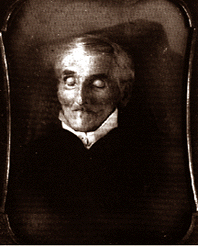 During the first few years of its existence, the daguerreotype--a small, highly detailed picture on polished silver--was an expensive luxury. As the number of photographers increased throughout the 1840s, the cost of daguerreotypes diminished. Other, less costly procedures were introduced in the 1850s, along with novel forms of portraiture like the ambrotype (on glass), the tintype (on thin, cheap metal), and the carte-de-visite (on paper). By the 1860s, photographic portraiture was affordable to virtually all members of society.
During the first few years of its existence, the daguerreotype--a small, highly detailed picture on polished silver--was an expensive luxury. As the number of photographers increased throughout the 1840s, the cost of daguerreotypes diminished. Other, less costly procedures were introduced in the 1850s, along with novel forms of portraiture like the ambrotype (on glass), the tintype (on thin, cheap metal), and the carte-de-visite (on paper). By the 1860s, photographic portraiture was affordable to virtually all members of society.
The making of a portrait photograph was a memorable occasion. The results had an importance for their subjects that would diminish in the twentieth century, after photography had ceased to be a novelty. A portrait photograph was an expression of identity and of individual worth. It was particularly valued in America, a nation undergoing a process of self-definition, and in which individualism was seen as a national trait.19 A postmortem photograph, which represented the loss of an individual, had a value beyond that of an ordinary portrait.
That value was reflected in its cost. As a specialty item, a postmortem photograph was more expensive--sometimes considerably more expensive--than an ordinary portrait. 20 In part, this had to do with the unusual requirements of its making, if only because the photographer had to come to the subject rather than the other way around. However, this by itself could not have justified the high price of a postmortem picture. Photographers, no less astute than other business people, were charging an extraordinary fee for a product desired with extraordinary fervor by their customers. Whatever the reason for the high fees, the commissioning of a postmortem photograph often involved an economic sacrifice.
Postmortem photography has one precedent in a centuries-old tradition of mourning portraiture in painting. These pictures are not at all like the earlier images of the ars moriendi. They are individual portraits rather than generic characterizations, and they depict their subjects after death rather than before. The earliest examples, made in northern Europe in the sixteenth century, show a recently-deceased subject, usually a nun or a clergyman, lying or sitting up in bed. Laypersons, especially children, began to be depicted in the seventeenth century.21

Many American postmortem photographs depict their subjects in a similar manner. Though the photographs can be considered a perpetuation of this tradition, it is not known whether the tradition is continuous, since the only pieces of evidence for its persistence are the postmortem photographs themselves. It is possible that the motif was brought from Europe, or it may be that the creators of both kinds of picture followed a similar logic--since most people died in bed, it was a sensible place to depict them. The setting, moreover, would be consistent with the last memories of the survivors.
Some of the photographs differ from their painted predecessors by depicting their subjects as if they were asleep. The concept of death as sleep has am extremely long history. It appears in Homer and Virgil, in medieval Christian liturgy, and in common parlance even today, when reference is made to the "repose" of the dead.22 It had a sentimental appeal in the nineteenth century, as it corresponded to the urge to symbolically maintain the presence of the deceased person within the circle of the family. Someone who is asleep may, after all, wake up, if only in the dreams or fantasies of the living.
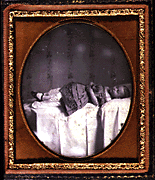
As a denial of death. this phenomenon is defined by modern psychiatry as an aspect of acute grief.23 In this view, normal grief is a process of "emancipation from the bondage to the deceased, readjustment to the environment in which the deceased is missing, and the formation of new relationships," while acute grief as an inability to make these adjustments.24 An initial dwelling upon a mental image of the deceased is considered to be normal. In acute grief, which is regarded as pathological, it becomes a preoccupation.
From a sociological perspective, on the other hand, grief is a concept embedded in culture. In this view, grief in nineteenth century America is explainable by the fact that society was undergoing a confusing and disorienting transition from an extended family system to a small family system. The small family system, moreover, is a form of socialization that creates overidentification and overdependence, and in which each person appears to the others to be irreplaceable.25 In this type of social group, denial is a comprehensible response to the death of a family member.
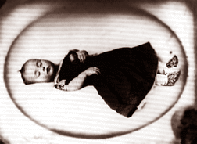
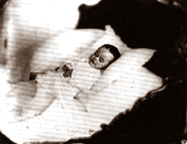
It can be seen in another of the precedents for postmortem photography. A form of painted mourning portraiture that became popular in the early nineteenth century depicts the deceased subject, usually a child, as alive. The only indication that the subject is dead is the presence of special symbols, recognizable to the nineteenth century viewer. A rose held downward or by a broken stem indicates a life cut short, as does the presence of morning glories--flowers that bloom, wilt, and drop from the vine in less than a day. A boat on calm water symbolizes an easy death, on stormy water a difficult one. A watch indicating the time of death might be prominently featured. More obvious indicators, like tombstones or weeping willows, are also sometimes employed. 26
Though most of these symbols do not appear in postmortem photographs--no doubt because the dead body is itself an unavoidable signifier of mortality--flowers do appear frequently, particularly in photographs of children. Some postmortem photographs, however, are evidence of an impulse very similar to that of the painted mourning portraits. Unlike most postmortem photographs, these show their subjects in postures of life, usually sitting up in chairs. The best of them almost preserve the illusion of life, while others fail pathetically. In some examples, an attempt has been made to further the illusion by hand-coloring the face of the dead person.
In the rouging of cheeks, the role of the postmortem photographer comes intriguingly close to that of an undertaker. The photographer, like the undertaker, uses color to restore the appearance of life. The two roles are similar in another, more general sense--the making of a postmortem photograph is, like embalming, a preservation of the body for the gaze of the observer. Both acts reject the finality of death. 27 The work of the photographer is simply more permanent.
The analogy is similar in the case of yet another precedent for postmortem photography, this one quite ancient: the funerary effigy. Republican Roman nobility displayed sculpted images of deceased family members in their family shrines. The purpose of the effigy was to convincingly exhibit the character and virtue of the dead man. The sculptor did this by rendering the features of the subject as realistically as possible. For this reason, the most realistic of these effigies were made of wax. These of course do not survive, but others carved in stone or marble still exist. According to ancient sources, the figures were more often shown sitting up than lying down. 28
Wax effigies were also used for funerary purposes in Europe from the fourteenth to the eighteenth centuries. In these, too, the desired effect was complete realism. Some also show their subjects in a seated position. The objectives of funerary effigies and certain postmortem photographs can thus be seen to coincide. Both attempt to depict the dead as if they were alive.
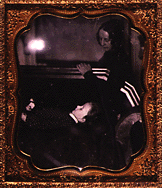 Photographs that portray death as sleep, or death as life, do not represent the majority of postmortem pictures. Most avoid metaphor, and instead simply reflect the circumstances of their making. In most cases, the photographer arrived after the dressing and preparation of the body. In the first half of the century, this would have been done by the family, especially in rural areas. The preparations, the display of the body, and the coffin, were usually simple. By the end of the century, after the family's role had been assumed by an undertaker, the preparations, the coffin (now a "casket"), and the presentation of the body would be considerably more elaborate. 29
Photographs that portray death as sleep, or death as life, do not represent the majority of postmortem pictures. Most avoid metaphor, and instead simply reflect the circumstances of their making. In most cases, the photographer arrived after the dressing and preparation of the body. In the first half of the century, this would have been done by the family, especially in rural areas. The preparations, the display of the body, and the coffin, were usually simple. By the end of the century, after the family's role had been assumed by an undertaker, the preparations, the coffin (now a "casket"), and the presentation of the body would be considerably more elaborate. 29
Early postmortem photographs have more variety than later ones. The body, for instance, may be depicted outside of the coffin, whereas in later pictures this almost never happens. Before the days in which the undertaker directed the proceedings, the photographer was given relative freedom to place and pose the body. After those days, the photographer was in most cases merely documenting the work of the undertaker. The pictures, like the funerary proceedings, followed a routine formula.
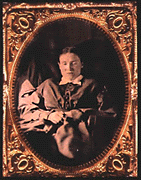 Even the early examples have predictable variations. Subjects are depicted either closeup or full length, either in profile or full face. The camera may be above or below the subject, but it is much more frequently at the same level. The face is almost always emphasized. The result is a very direct confrontation with a dead person. In later postmortem photographs, this confrontation is mitigated by the presence of flowers, sometimes to such an extent that the body becomes difficult to locate.
Even the early examples have predictable variations. Subjects are depicted either closeup or full length, either in profile or full face. The camera may be above or below the subject, but it is much more frequently at the same level. The face is almost always emphasized. The result is a very direct confrontation with a dead person. In later postmortem photographs, this confrontation is mitigated by the presence of flowers, sometimes to such an extent that the body becomes difficult to locate.

Postmortem photography also reflects more general social circumstances. The high incidence of photographs of dead children echoes the high infant mortality rate that existed throughout the century. Other manifestations of this are abundant. In American census files, for instance, children under the age of one year are often listed as "unnamed" or "anonymous" because their survival was not yet certain; frequent expressions of the tentativeness of young lives can also be found in the correspondence of the period. 30 An entire body of consolation literature came into being to help grieving parents, especially mothers, in dealing with the loss of a child. 31 An unsigned poem, published in Harper's Weekly in 1880, and part of this burgeoning literary genre, might easily be describing a postmortem photograph: "Look on his pretty face for just one moment, his braided frock, his dainty shoes,/His firm-shut hand, the favorite plaything in it...." 32 A postmortem photograph was, in many cases, the only portrait made of a child. In the early years of photography, this was true of many postmortem pictures of the elderly as well. It remained true of children for the rest of the century.
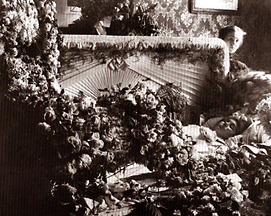
Though almost all postmortem photographs were private images, postmortem pictures of public figures were also made on occasion. However, on at least one of these occasions, the photograph was suppressed. The photographer was the celebrated Jeremiah Gurney, and the event was the funeral ceremony for Abraham Lincoln in New York City. General Edward D. Townsend, who represented the U.S. Army during the lengthy funeral proceedings (and who appears in the photograph), gave Gurney permission to photograph the body of Lincoln as it lay in state in New York's City Hall. When Secretary of War Edwin Stanton learned of this, he ordered the destruction of the negatives. A full-size plate was immediately destroyed, but Gurney retained a smaller, stereo plate while attempting to get Stanton to rescind his order. This did not happen, and the stereo plate was also destroyed, but a print made from it was found in Stanton's papers after his death. The photograph was finally published in 1952, in Stefan Lorant's picture biography of Lincoln. 33
Stanton's reasons for suppressing the picture can easily be surmised. The grief of the American public over the death of President Lincoln was tremendous, and resulted in the lengthiest and most heavily-attended funeral (actually, successive funerals, at a succession of sites) in the history of the United States. Since Lincoln's body was in an open casket on public display, and was viewed by thousands of people, the sight of the body could not have been considered inappropriate. Photographs of many of the things and events connected with the assassination and funeral were widely circulated. So, too, were written accounts illustrated with woodcuts. 34 Nevertheless, these pictures and accounts dealt with the fact of Lincoln's death only at second hand. The dissemination of a grimly vivid photograph of the body may have been considered inadvisable at a time when violent anti-Southern feelings were being provoked by the assassination. 35
Although Stanton appears to have felt that the circulation of a postmortem photograph of Lincoln would stir emotions that were better left unstirred, he was probably wrong. Lincoln's death was a fact that could not be denied, yet so traumatic that it could not be easily accepted. As the reportage of the time suggests, many people were able to accept it only after personally viewing the body. The photograph might have provided a substitute for this experience for the many other people who were unable to do so. Like many other deaths, Lincoln's perhaps had to be denied before it could be accepted. Like other postmortem photographs, Lincoln's might perhaps have assisted its viewers in doing both.
Memento Mori: Death and Photography in 19th Century America by Dan Meinwald
 During the first few years of its existence, the daguerreotype--a small, highly detailed picture on polished silver--was an expensive luxury. As the number of photographers increased throughout the 1840s, the cost of daguerreotypes diminished. Other, less costly procedures were introduced in the 1850s, along with novel forms of portraiture like the ambrotype (on glass), the tintype (on thin, cheap metal), and the carte-de-visite (on paper). By the 1860s, photographic portraiture was affordable to virtually all members of society.
During the first few years of its existence, the daguerreotype--a small, highly detailed picture on polished silver--was an expensive luxury. As the number of photographers increased throughout the 1840s, the cost of daguerreotypes diminished. Other, less costly procedures were introduced in the 1850s, along with novel forms of portraiture like the ambrotype (on glass), the tintype (on thin, cheap metal), and the carte-de-visite (on paper). By the 1860s, photographic portraiture was affordable to virtually all members of society.






